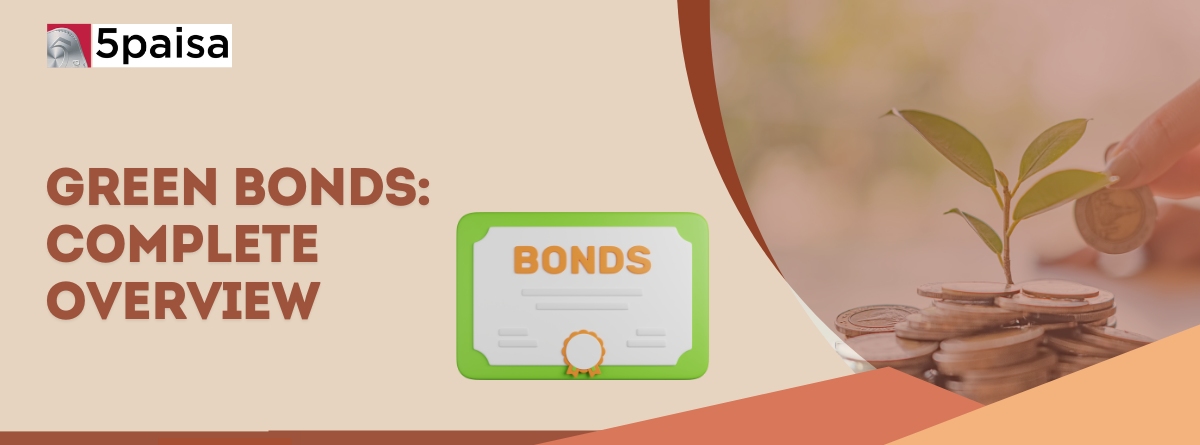Content
Green bonds are intended to promote sustainability and aid in environmental projects that address climate change or other issues. They contribute to the funding of initiatives that cover everything from energy efficiency to the preservation of land and aquatic ecosystems to sustainable forestry and agriculture. They also provide funding for climate change mitigation and the development of eco-friendly technologies. Similar to other bonds, green bonds are more appealing than comparable taxable bonds because they frequently offer tax incentives in the form of credits and exemptions.
Unlock the full article - sign in with Gmail!
Expand Your Market Knowledge with 5paisa Articles
What is a green bond?
Green bonds have gained popularity as a way for investors to match their financial objectives with their values and have a good impact as the globe turns more and more toward tackling climate change and other environmental issues. One kind of fixed-income investment used to finance initiatives that have a good environmental impact is the green bond. Similar to conventional bonds, green bonds promise investors a specified rate of return and the use of the money to partially or fully finance sustainable initiatives.
To collect money for projects that support a more sustainable economy and produce observable climatic, environmental, or other advantages, governmental, corporate, or multinational organizations issue these bonds. Renewable energy, energy efficiency, clean public transportation, pollution prevention and control, conservation, sustainable water and wastewater management, and green buildings that adhere to globally accepted standards and certifications are among the projects that green bonds fund.
What is history of green bonds?
The total value of all green bonds issued as recently as 2012 was under $2.6 billion. However, as countries impose more regulations to combat climate change, the market has exploded in recent years, and many investors seek investments that satisfy their ESG objectives.
Green bond sales reached a record $575 billion in 2023, according to Bloomberg. During the year, governments issued $190 billion worth of green bonds.
Demand is anticipated to rise in the upcoming years as a result of lower borrowing costs made feasible by anticipated interest rate declines and European laws aimed at enhancing the green bond market's comparability, transparency, and trustworthiness. S&P Worldwide. "Global Green Bond Sales to Get Boost in 2024 as Interest Rates May Fall."
What kinds of Green Bonds are there?
Although all green bonds serve as a type of debt financing for environmental projects, each one's unique features may vary depending on the issuer, the intended use of the proceeds, and the bondholders' access to the issuer's assets in the event of a liquidation, among other things. There are several varieties of green bonds on the market, including the following:
1. Bonds for "use of proceeds": Although the focus of these instruments is financing green initiatives, the lenders have access to the issuer's other assets in the event of a liquidation. Their credit rating is identical to that of the issuer's other bonds.
2. "Use of proceeds" revenue bonds or asset-backed securities: These securities can be used to fund or refinance green projects, but the issuer's revenue streams—such as taxes or fees—serve as the security for the debt. When issuing green bonds, states and municipalities frequently choose this kind of arrangement.
3. Project bonds: These are restricted to a certain underlying green project, so investors can only access project-related assets.
4. Securitization bonds: These combine several projects into one debt portfolio, giving bondholders access to the assets supporting the entire collection of projects.
5. Covered bonds: The "covered pool" is a collection of green projects financed by these debt instruments. Investors have access to the issuer in this situation, while bondholders have recourse to the covered pool if the issuer is unable to fulfill debt payments.
6. Loans: Green project financing can be either unsecured or secured (backed by collateral). Lenders have complete access to the borrower's assets when they offer unsecured loans. Lenders have access to the collateral for secured loans.

What are the benefits of green bonds?
Green bonds have been becoming more and more popular, mostly due to investors' adoption of socially conscious investing rather than their superior risk and return potential over traditional bonds. As previously stated, green bonds function similarly to traditional bonds.
Nevertheless, depending on the issuer and area, green bonds may provide tax benefits including tax credits and exemptions. This is done to entice investors to fund climate and/or environmental projects.
What Is the Biggest Obstacle to Purchasing Green Bonds?
Purchasing green bonds may present a number of difficulties. Since you'll need specific details regarding the use of revenues and the environmental impact of supported projects, transparency and reporting may result in some homework. Furthermore, the market for green bonds is still in its infancy, and certain bonds can be less liquid than conventional ones, making it more difficult to buy or sell at the right times and prices. Since there are no legally enforceable rules for the frequently used nongovernmental standards, there may be misunderstandings over what constitutes a green bond due to the absence of a common standard in the market.
Conclusion
Green bonds are debt instruments created to support green initiatives. Unlike other bond kinds, green bonds may include tax benefits that encourage investment in environmentally friendly initiatives. Bond issuers' sustainability claims should be checked by investors looking for assets that reflect their environmental ideals.




